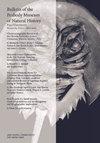Disentangling the Influence of Urbanization and Invasion on Endemic Geckos in Tropical Biodiversity Hot Spots: A Case Study of Phyllodactylus martini (Squamata: Phyllodactylidae) along an Urban Gradient in Curaçao
IF 0.9
4区 哲学
Q2 BIODIVERSITY CONSERVATION
引用次数: 9
Abstract
Abstract Predicting the response of endemic species to urbanization has emerged as a fundamental challenge in 21st century conservation biology. The factors that underlie population declines of reptiles are particularly nebulous, as these are often the least understood class of vertebrates in a given community. In this study, we assess correlations between feeding ecology and phenotypic traits of the Lesser Antillean endemic Dutch leaf-toed gecko, Phyllodactylus martini, along an urban gradient in the Caribbean island of Curaçao. There has been a marked decline of this species in developed habitats associated with the invasive tropical house gecko Hemidactylus mabouia. We find a correlation between aspects of locomotor morphology and prey in undeveloped habitats that is absent in developed habitats. Analyses of stomach contents further suggest that Phyllodactylus martini alters primary prey items in developed areas. However, changes in prey promote the overlap in foraging niches between Phyllodactylus martini and Hemidactylus mabouia, suggesting that direct resource competition is contributing to the decline of Phyllodactylus martini. In addition to competitive exclusion, we suggest that the urban extirpation of Phyllodactylus martini could also be attributed to a top-down control on population growth by Hemidactylus mabouia. Colonizations of walls put Phyllodactylus martini in direct contact with Hemidactylus mabouia increasing the chances for predation events, as evidenced by our observation of a predation event on a Phyllodactylus martini juvenile by an adult Hemidactylus mabuoia. In total, our results add to a growing body of literature demonstrating the threat that invasive synanthropic reptiles pose to endemics that might otherwise be able to cope with increased urbanization pressures.城市化和入侵对热带生物多样性热点地区特有壁虎的影响——以库拉帕拉奥城市梯度马氏毛趾壁虎为例
预测特有物种对城市化的响应已成为21世纪保护生物学的基本挑战。导致爬行动物数量下降的因素尤其模糊,因为在一个特定的群落中,爬行动物往往是最不为人所知的一类脊椎动物。在这项研究中,我们评估了小安的列斯岛特有的荷兰叶趾壁虎(Phyllodactylus martini)沿城市梯度的摄食生态与表型性状之间的相关性。在与入侵的热带壁虎半爪虎(Hemidactylus mabouia)相关的发达栖息地,该物种的数量明显下降。我们发现在未开发的栖息地中运动形态和猎物之间的相关性在发达的栖息地中是不存在的。对胃内容物的分析进一步表明,在发达地区,马提尼phyllodytylus改变了主要的猎物。然而,猎物的变化促进了马提尼Phyllodactylus和马布亚半指趾lus在觅食生态位上的重叠,表明直接的资源竞争是马提尼Phyllodactylus数量下降的原因之一。除了竞争排斥外,我们认为马氏半趾蝗在城市的灭绝也可能是由自上而下的马氏半趾蝗对种群增长的控制引起的。墙的殖民地使马提尼Phyllodactylus与马布半趾蚜直接接触,增加了捕食事件的机会,我们观察到一只成年马布半趾蚜对马提尼Phyllodactylus幼崽的捕食事件就是证据。总的来说,我们的研究结果增加了越来越多的文献,证明了入侵的共栖爬行动物对地方性动物构成的威胁,否则它们可能能够应对日益增长的城市化压力。
本文章由计算机程序翻译,如有差异,请以英文原文为准。
求助全文
约1分钟内获得全文
求助全文
来源期刊

Bulletin of the Peabody Museum of Natural History
BIODIVERSITY CONSERVATION-ECOLOGY
CiteScore
2.40
自引率
0.00%
发文量
6
审稿时长
>12 weeks
期刊介绍:
The Bulletin of the Peabody Museum of Natural History publishes original research based on specimens, artifacts and related materials maintained in the collections of the Yale Peabody Museum of Natural History’s curatorial divisions. The Bulletin is published twice a year, in April and October.
 求助内容:
求助内容: 应助结果提醒方式:
应助结果提醒方式:


